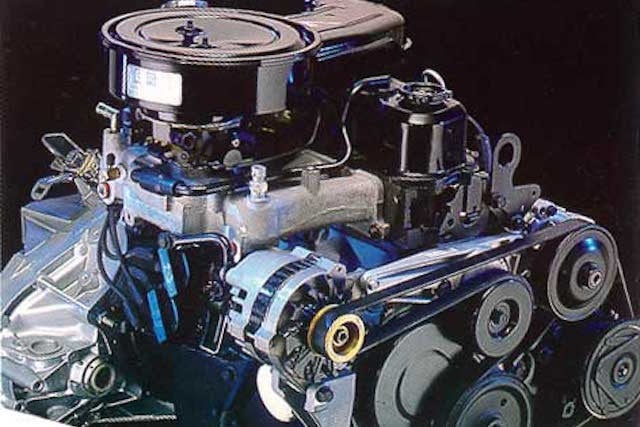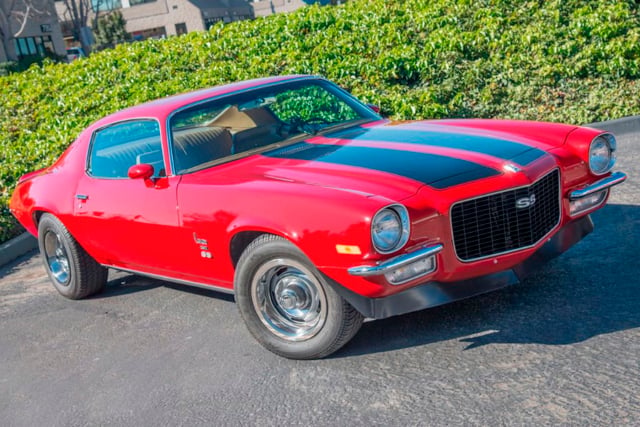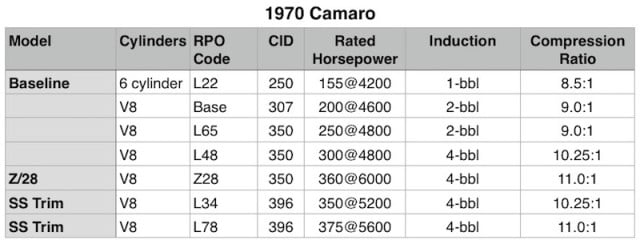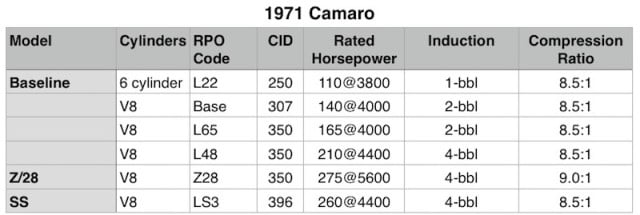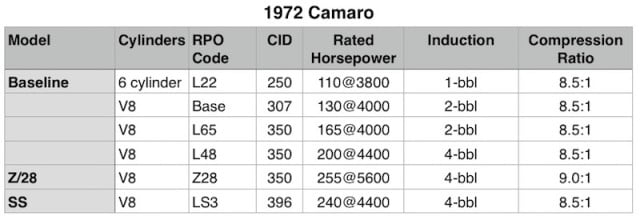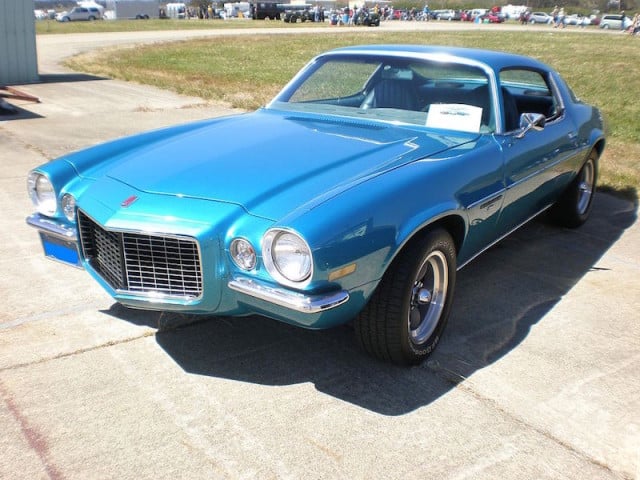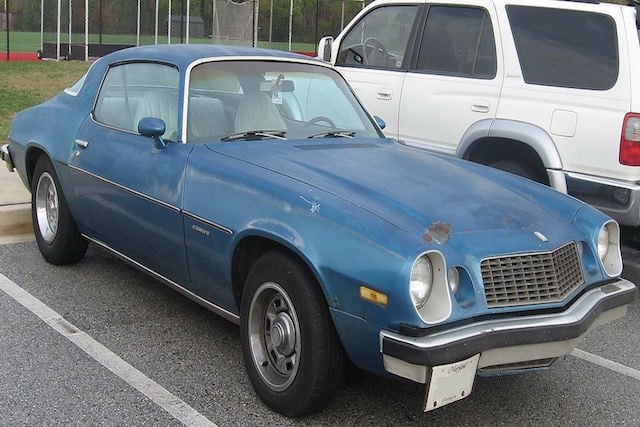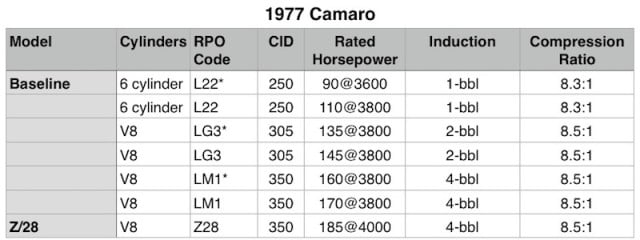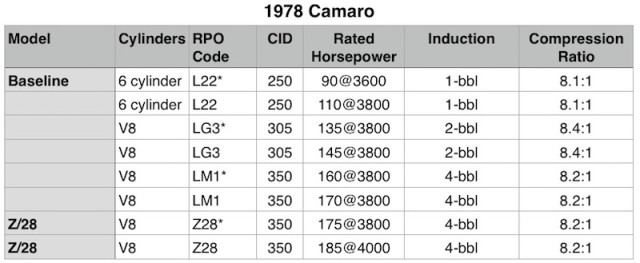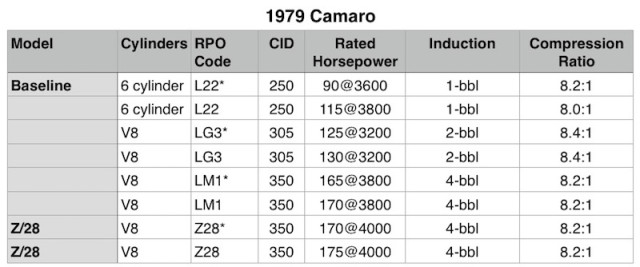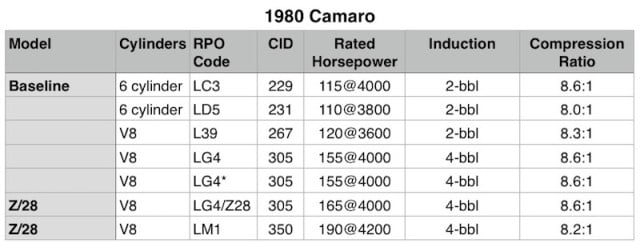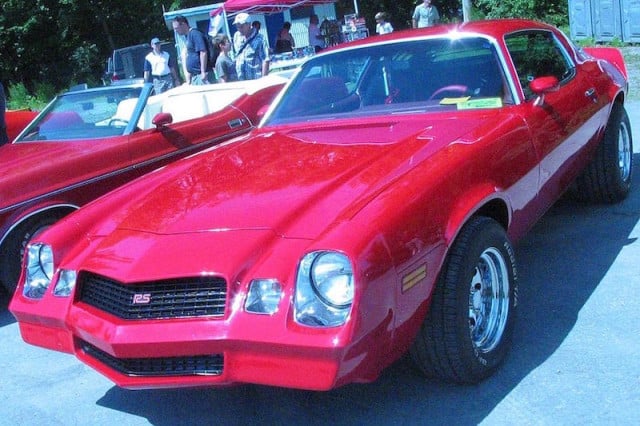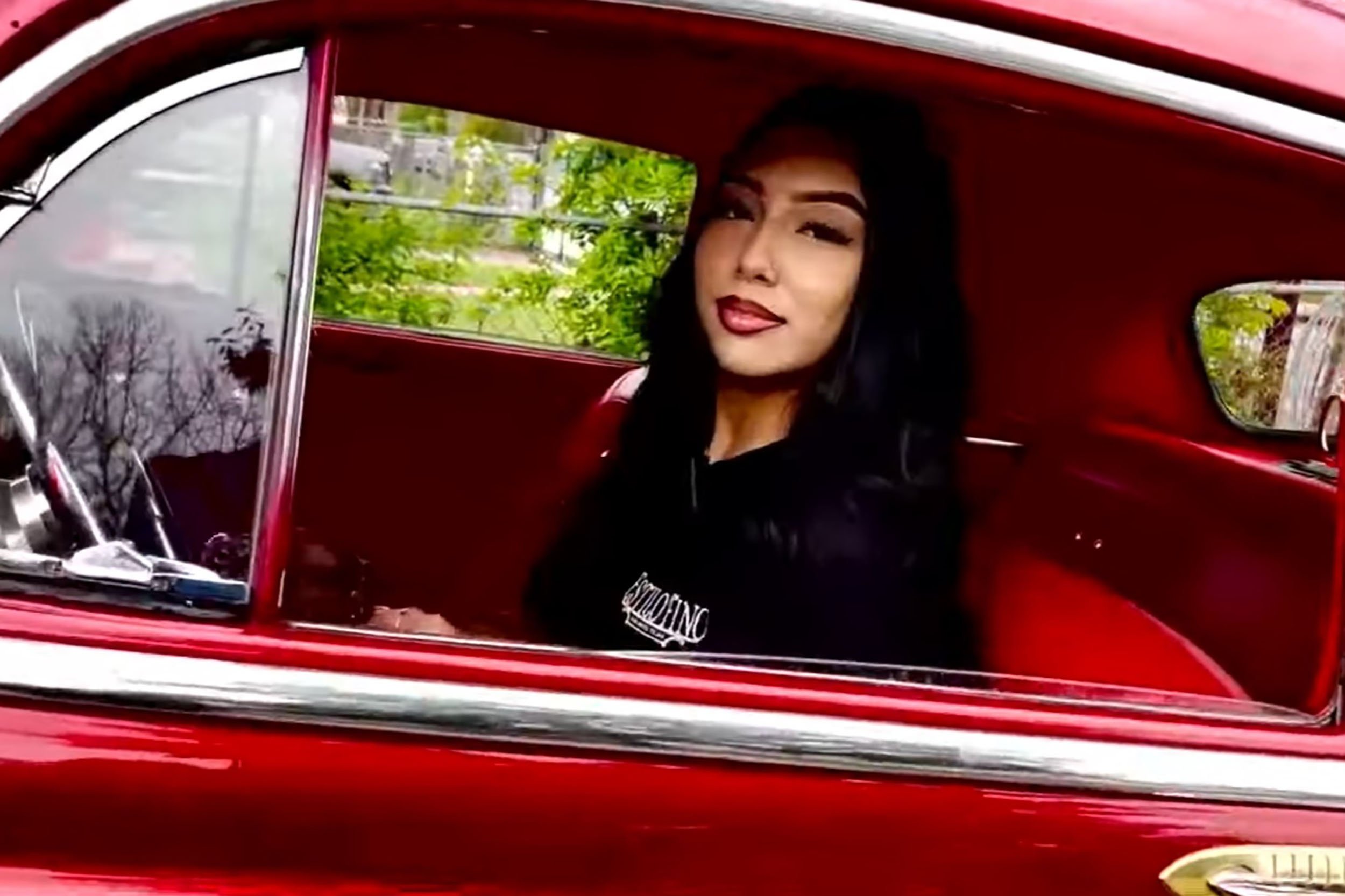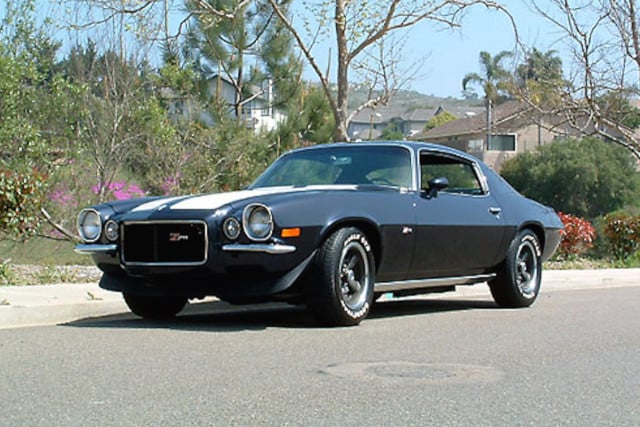
1970 Camaro Z/28. All photos from wikipedia.org
Continuing our look at Camaro engines through the years, we completed our review of the first generation Camaro engines last month and are focused on the second generation Camaro engines from 1970 through the 1981 model year.
The Camaro’s second generation started off with the most powerful array of engines offered in the personal coupe/pony car style chassis. Federal regulations soon changed the performance level of automotive engines as the industry entered a tumultuous time adjusting to the changes in unleaded fuel and lower emissions.
1970 Camaro Engines
Second Generation Camaro Engines
- 1970 – 1979: L22 250ci inline 6
- 1970 – 1973: L14 307ci V8
- 1970 – 1975: L65 350ci V8
- 1970 – 1974: L48 350 ci V8
- 1970: L34 402ci V8
- 1970: L78 402ci V8
- 1970 – 1972: LT-1 350ci V8
- 1971 – 1972: LS3 396ci V8
- 1973 – 1974: Z28 350ci V8
- 1974-1979: LM1 350ci V8
- 1977-1979: Z28 350ci V8
- 1976 – 1980: LG3 350ci V8
- 1980-1981: LC3 229ci, V6
- 1980-1981: LD5 231ci V6
Big-block engines were dropped early in the second generation and the inline 6-cylinder gave way to the V6 at the end of the run. The small block was the only engine family to last through the entire second generation, ranging from a high of 375 horsepower for the 1970 Z28 to 115 horsepower by the mid- and late-1970s.
Camaro output peaked in 1970, with 375 hp and 415 lb-ft (big-block SS Camaro), but by 1975 the most powerful V8 model offered only 155 hp. The Camaro wouldn’t see more than 200 horsepower again until the mid-1980s. Sadly, this marked the last year for 9-plus compression ratio engines.
The base 6-cylinder changed to the L22 inline 6 and the L26 was dropped completely. The L22 would remain the base 6-cylinder engine until 1979 when it would be replaced with a pair of V6 options.
The base V8 was a the L14 307ci V8. Topped with a two-barrel Rochester, the L14 pushed out a modest 200 horses, which looked tame when compared to the some of the other engine options. The optional engine for the baseline coupe was the L65 350ci, which pumped up the horsepower to 250hp with the same carburetor.
Consumers could get the L48 350ci V8 in the SS performance package or step up to the big-block packages with either the L34 or L78 engines. These were labeled as 396 cubic inch engines but were actually 402ci. The “396” cars received black paint on the rear panel and the special engine designation on the front fenders. The L78 equipped SS Camaros required positraction rearends.
Two 454ci big-block engines were listed in sales brochures as LS6 and LS7, but they never made it to production.
The 1970 Z28 special performance package featured a 350ci small-block Chevy for the first time. SCCA Trans Am rule changes allowing the larger engine meant that the Camaro was able to use the engine and still be race legal.
The Z/28’s engine was a slightly tweaked version of the Corvette LT-1 featuring four-bolt mains, forged steel crank, impact extruded pistons, and an 11:1 compression ratio. The Standard cam was the optional cam from 1969 that boasted 317-degrees intake duration and 346-degrees exhaust with a lift of 0.458 inches on both the intake and exhaust. Carburetion was a Holley 780-cfm (4150) 4-barrel mounted to a new high-rise aluminum manifold. The larger engine allowed an automatic transmission in the Z/28 for the first time as well. The 12-bolt rearend and tuned suspension were mandatory for the Z/28.
1971 Camaro Engines
GM President Ed Cole began to lead the company through Federal Regulations brought about by the 1970 amendments to the Clean Air Act. The focus from the environmental standpoint was to eliminate leaded fuel as specified in the clean fuel vehicle part C of the amendments. GM responded by lowering the compression ratios of all the engines to a maximum of 9.0:1. Because this lowered horsepower numbers that are used in sales literature, GM began to rate the horsepower of the engines in SAE Net hp. Both SAE Net and gross hp were used in sales ads in 1971.
The LT-1 350 V8 used in the Z/28 dropped from 360 hp SAE gross to 330 horsepower (250 kW) SAE gross due to the compression ratio decrease. Gone from the lineup were the L34 and L78 402ci engines and a lower compression ratio LS3 402 took their place. The L48 engine went from 10.25:1 compression to 8.5:1.
Still to come were the “inline scrubbers” in the exhaust to reduce emissions from the tailpipes. GM and the other car companies began to work on components like catalytic converters to meet the future regulations.
1972 Camaro Engines
The 1972 model year was a forgettable year all the way around for Camaro fans. Labor problems hurt the production, insurance rates on performance cars was up putting a higher price on larger engines, gasoline prices were at an all-time high, and the federal regulation on emissions and safety were taking a toll on performance and design. As a result, sales of personal coupes were down for all car companies.
This would be the last year for the Super Sport model and the larger engines that supported this power package. Also making its last appearance in the second generation Camaro was the big-block engine. All of the 1971 engines were carried over to the 1972 year with greater emission controls and lower output ratings. If there was anything to cheer for, it was that the Camaro still had a choice of six different engine options.
1973 Camaro Engines
The engine output of each of the five powerplant options continued to drop and the Z/28 saw a new 350ci 245hp engine in place of the once great LT-1. Crippled by regulations, the once proud Z/28 power package was being looked at for cancellation. With the lowest output yet for the Z/28 at 245hp, air conditioning was offered for the first time.
The Super Sport model and its potential engine options were dropped from the lineup. The big-block LS3 was also dropped from the engine options. The Camaro’s engine choices were down to five, and all of them were weak in comparison to the previous years. Despite the trend downward in engine performance, sales were up slightly for the year.
1974 Camaro Engines
While the rest of the automakers had given up on personal coupes (Ford downsizing to the Mustang II, Mercury upsizing the Cougar and Chrysler killing off the Plymouth Barracuda and Dodge Challenger), GM soldiered along with the Camaro and the Firebird. As the Arab oil embargo was ramping up to painful proportions, the Camaro set sales records, due in large part to a loyal owner base along with consumers lack of sport coupe choices in the marketplace.
The 1974 Camaro grew seven inches longer and added weight with additional safety requirements. With the ever increasing emissions requirements causing engine power to be chocked down to all-time lows, GM engineers attempted to improve fuel mileage by raising gear ratios. This worked well for highway travel but killed acceleration on the city streets, which hurt the Camaro’s performance. Heavier and slower every year seemed to be the continuing trend during the early 1970s.
The L14 307 V8 was dropped as an option and the LM1 350 made its debut. The rest of the engine lineup was carried over from 1973 with the one bright spot being the Z/28 engine, which held its own. Featuring larger valves in the cylinder heads, the engine package was the same as in 1973 except for the addition of an HEI ignition system at mid-year.
1975 Camaro Engines
1975 will go down in history as the year of the catalytic converter. Even with the device added to the exhaust system, the air injection reactor (AIR) was still utilized. Reduced emission levels allowed for engine tuning for higher power levels but nothing like the pre-1972 power levels. The power plant selection was limited to the L22 6-cylinder or the retuned L65 and LM1 350 V8 engines. Air conditioning was now available with the 6-cylinder offering.
Sadly, the RPO Z28 power package was discontinued for 1975. GM claimed they dropped the Z/28 option due to the restrictive emission standards that hampered the higher output V8 engines. Engines that were offered in 1975 continued to reflect the impact of these regulations in their declining horsepower ratings. The two 350ci V8s produced 145hp and 155hp.
Meanwhile, the Camaro started to make a name for itself on the track under it’s new identity, the car of the International Race Of Champions (IROC). This series showcased the best drivers from different series in equally prepped Camaros in a series of their own. No one knew how popular these cars would become.
1976 Camaro Engines
The 250ci inline 6-cylinder L22 returned as the standard engine in the baseline sport coupe while the 305ci V8 engine makes its debut as the 140hp LG3. The 305ci became the standard engine for the LT trim model and the optional engine in the sport coupe. The bigger 350 cubic-inch V8 was only available with a four-barrel carburetor and rated at 165 horsepower.
Despite the limited engine options and the low horsepower, the Camaro’s popularity was soaring. Sales jumped making the 1976 model year the best year yet for the second generation.
1977 Camaro Engines
The L22 6-cylinder, LG3 and LM1 engine platforms were continued on with one major addition: California cars received extra emissions components. Not only were there hoses galore, with rubber hoses running from carburetors to fuel tanks to charcoal canisters… but the engine camshafts were tuned down for emission control. Engine builders quickly figured out that horsepower could be gained back with a more aggressive camshaft. The California engines were down 20hp in the 6-cylinders and 10hp in the V8 models. The 6-cylinder engines were also capped at 8.3:1 compression ratio.
Because of the popularity of the Firebird Trans Am, Camaro brought back the Z/28 with a 350ci tuned to a whopping 185hp, but the legend was back and soon to reach legendary status with the IROC series gaining popularity. The IROC racers drove Camaros from 1975 through the entire second generation of Camaro.
1978 and 1979 Camaro Engines
The same engine packages, along with the California versions, carried the Camaro through 1978 and 1979 with the 1978 Z/28 engine basically identical to 1977. The Camaro may not have regained its powerful engine ratings from the pre-emission days but they were still dominating the showroom. Camaros outsold Mustangs 247,437 to 179,039 for the 1978 model year. Compression ratios changed across the board for all of the 1978-79 Camaro engines, holding horsepower down.
1980 Camaro Engines
Major engine changes came in the 1980 model year with the longtime L22 250ci 6-cylinder being replace by a 229ci V6 engine. California models received the 231ci engine. This was the first time that a V6 was offered in a Camaro. The 229ci was designated as the LC3 and rated at 115hp (8.6:1 compression). The California V6 was labeled the LD5 and rated 110hp with an 8.0:1 compression ratio.
The V8 engine options for the base model, RS, and Berlinetta models included the L39, a 120hp 267ci V8 and the LG4 designated 305ci engine. California models got their own version of the LG4 which held the same horsepower as the 49-state Camaro at 155hp.
The legendary Z/28 hit the showroom floor with a tweaked up version of the LM1 which upped horsepower to 190hp – most powerful since 1974. This engine was not available in California whose Z/28s were equipped with with a 165hp LG4 305ci engine package.
1981 Camaro Engines
The 1981 model year represented the final year of the second generation Camaros. The engine packages were nearly unchanged from 1980 except that the Z/28 was powered by a 350ci V8 equipped with a CCC (Computer Command Control) unit as required by environmental regulations. The CCC system included the electronic Rochester 4bbl E4ME Quadra-Jet, where the primary side of the carburetor had the fuel metering controlled by computer.
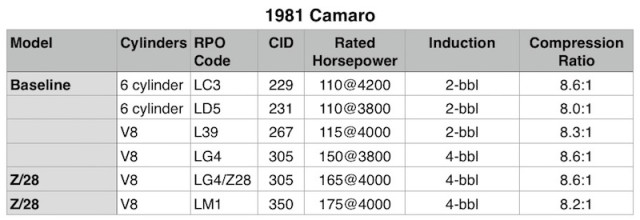 Looking Toward The Third Generation
Looking Toward The Third Generation
The second generation started out with a bang and the most powerful Camaros yet. After topping the power chart in 1971, the rest of the second generation engines were a hodgepodge of neutered V8s trying to meet federal regulations. Despite the regulatory oversight, the generation ended on a high note with the promise of bigger and better things.



